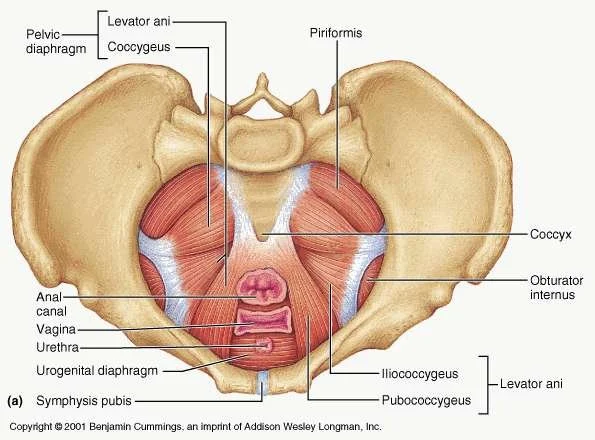Breathing well often tends to be forgotten as a key element during pregnancy or postpartum & can have significant effects on our bodies. Other factors that may affect diaphragm expansion include poor abdominal tone, a tense or tight pelvic floor, poor posture, and habitual shallow breathing. This is where a qualified pelvic floor PT (that’s us!) can help by assessing your specific needs and developing an individualized treatment plan. It can never hurt to at least get assessed! Breathing is one of our primal needs – and doing it well will always pay off!
Postpartum Anxiety
As a new parent, anxiety is a normal feeling to experience as you learn to treat old paths in a new way. However, just as we discussed last month about postpartum depression, there can come a point where anxiety about postpartum becomes postpartum anxiety (PPA). PPA is when a person experiences severe anxiety after childbirth or becoming a parent. These feelings can feel out of control and take over your thoughts. PPA appears to have a greater prevalence than postpartum depression, but is often underrecognized and undertreated.
Postpartum Depression
up to 15% of new moms may experience a more severe and longer-lasting version called postpartum depression (PPD). PPD may occur if the “baby blues” extend longer than that initial two week period – and may occur for up to a year after birth. Unlike the “baby blues,” PPD does not go away on its own. Postpartum depression can make it hard to get through the day and may affect your ability to take care of your baby – and yourself!
6 Weeks - months after birth (Postpartum)
The “latent” period of postpartum recovery occurs from 6 weeks to 6 months after delivery but full postpartum recovery takes up to 2 years (that we are aware of in 2025). By that time, your hair should stop falling out. You should no longer have physical symptoms (like bladder leakage or Diastasis Recti). Your period may come back around the 6 month mark, but it could take up to 2 years for your hormones to re-balance. If you’ve had a C-section, you may feel more tired at the 6 month mark than those who had a vaginal delivery. Mentally, you may be getting more into a routine as your baby is sleeping more. Though, of course, it is important to address any lingering mental health concerns.
Weeks 1-2 Postpartum
Here at Recharged PT, we’ve talked extensively about what to expect prior to getting pregnant as well as the 1st, 2nd, and 3rd trimesters. Heck, we’ve even done a deep dive on the fourth trimester. But, sometimes, it can be helpful to get back to basics: what your recovery may look like after you give birth. Having a general timeline for postpartum recovery can be helpful - here are the first two weeks laid out for you.
Pregnancy Swelling!
We’re here today to talk about maybe one of the most common complaints seen during pregnancy and postpartum: swelling.
Swelling during pregnancy is usually pretty common in the lower extremities and feet. All the extra fluid that your body creates to help support a healthy baby can cause blood circulation to slow – and much of it accumulates in the legs and feet. Especially if you are up on your feet a lot!
Bladder Prolapse
Cystocele (SIS-toe-seel) is when the bladder drops from its usual position and presses on the vaginal wall. A type of pelvic organ prolapse, cystocele or anterior vaginal prolapse, can occur if the pelvic floor muscles are weak, the organ is not in the correct spot in the pelvis in general (especially post child birth) or if there is too much pressure put on the pelvic floor. Common causes of a prolapsed bladder include repetitive stress over time (e.g., coughing, improper lifting) or during vaginal childbirth.
After Surgery- Post Op
Today we are talking about how to care for yourself after you have surgery- this could be anything from a C-Section to a knee replacement. The info contained here isn’t super specific but that doesn’t make it any less important!!
Having surgery and recovering from it can be a very challenging process physically, mentally, and emotionally. Whether you elect to have it done or the procedure is absolutely vital to your health and well-being, surgery is trauma to your body: it takes a toll.
Best Tools to use in Labor
Hi Everyone! Here are our favorite tools to use to assist with pain and hip movement during labor. The more you can handle the pain & the more movement your hips can do- the better and faster your labor will be!
We carry all of these things with us when we do Birth Support for our Mama’s!!
To find these on Amazon- just click on the photo!
Obturator Internus Pelvic Floor Pain
The Obturator Internus (OI) is a muscle that sits deep in the hip girdle, running from the front of the pubic bones and inserting onto the greater trochanter (the top bony part of the thigh bone). The OI is a deep hip stabilizer, which means it helps stabilize the head of the femur (thigh bone) to keep it in socket. This muscle is also responsible for external rotation – or rolling out– of the hip and thigh. Additionally, the OI shares a fascial connection to most, if not all, of the deep pelvic floor muscles. People with dysfunction of the Obturator Internus often complete of a deep groin, hip or back pain that won’t go away with regular stretching.
Pelvic Health, Pelvic Floor Rehab, Pelvic Floor Exercises, Pelvic Pain, Pain with Intercourse, Melbourne, FL, Postpartum, Postpartum Rehab, Pee Leakage, Dr. Paige, Dr. Laura, Recharged Performance Therapy
Abdominal Organ Mobilization
4th Trimester Part 2!
The 4th trimester also includes your baby’s adjustment into this crazy, colorful world! Dr. Antony Karp is credited with creating the concept of the 4th trimester. He posts that full-term babies are born three months too early relative to other mammals. This is possibly so that the head can fit through the birth canal. But, the flip side is that your baby’s nervous system is not yet fully developed – and has a hard time handling life outside a quiet, safe womb.
4th Trimester - part 1
A newly described phase of Pregnancy related care is being called the Fourth Trimester, lasting from birth until approximately 12 weeks postpartum.
This is a critical time for mommas that is often swept aside – there’s too much to do with a new baby, your house, all the family/friends trying to come over, and maybe your spouse… And if we are being honest, there not enough time or energy to do it all.
Mommy Tummy- Diastasis Recti
Diastasis Recti is a condition normally seen at the end of pregnancy and after birth. It is normal until about 12 weeks postpartum. If you are still experiencing a “gap” after 12 weeks, you need to see a Pelvic Floor Physical Therapist for Diastasis Recti!
Good News- There is a Pelvic Floor Physical Therapist for you here in Melbourne, FL!
The #1 thing to do for your C-Birth Scar
Did you have a C-Birth (C-section)? If you did, or may have one in the future, then you NEED to read this latest installment to our Blog! We go over the easiest ways to help your scar heal and look better too! And schedule an appointment with pelvic floor physical therapy. You will thank us, we swear.
Cesarean Section
Diastasis Recti Muscles
Postpartum Recovery
In this blog, Dr. Paige goes over a few tips and tricks to improving recovery after delivery of your baby! You just went through a life changing event and should be cared for- even though most people don’t talk about recovering after birth. Learn how to better care for you so that you can better care for your baby! But more than anything- you need to go see a pelvic floor physical therapist! They will change your life!


















